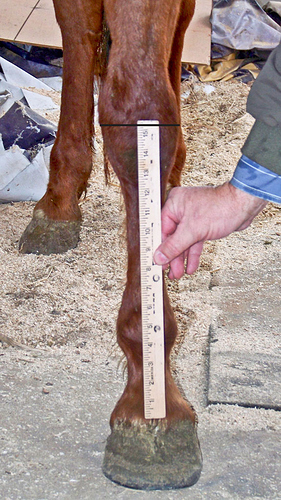One mare ended up 14.2 out of 15h mare, 15.2H stallion, stock horse breeding. Of the sporthorses, they were not string tested, but ended up at the mares height of 17h or taller. I point to gelding them young as the reason for extra height. After the first 2 colts got so big we changed to gelding them after yearling birthday when testosterone had started closing knees. It helps keep height smaller as fully grown horses.
3 colts by the same stallion out of matching 17h sisters, ended up at 18.1h, 17.1, full brothers. Third colt is 17h. Stallion owner said these 3 are the tallest he ever produced, most fall in the 16h to 16.2 range. Stallion himself was 16.2.
2 other full sibling, gelding is 17h, gelded at one year. Sister now 6, is 16.2, but really filled out this year. Not sure if she is done growing yet. Put on an inch and a half since spring, as well as bulking out. Stallion is 16.2h, mare about the same.
4yr old filly is now about 16.3h out if a 16.3 mare by the above 16.2 stallion. She still looks “immature” and I expect her to get taller as well as bulking out quite a bit. Her dam might have gotten bigger with better diet from weaning to age 2yrs when we bought her. She was kept in pasture with broodmares that ran her off the hay. Extremely thin at purchase, which I expect kept her smaller in spite of good feeding later…
Being so tall, they all keep growing longer than smaller horses. Finish about 7yrs, though the 18.1h horse was 8yrs old when height stopped and he filled out. The stock horse had all her height by age three, but added a lot of bulk in filling out until age 6yrs.
The later gelding plan was from a Texas A&M (I believe) size study on colts. Old study 1970s? Used lots of siblings, related animals, but left some entire, gelded others, gelded early and late, over years. Gelded young, growth went to height. Ungelded with testosterone went to building stallion physique, less height with knees closing earlier. In the study, geldings were always taller than stallions, even with the same breeding lines, full brothers . Late gelding still had taller horses than stallion heights. Consider later gelding if you want smaller geldings. We turn those colts out with older geldings for play and manners, herd living to be better to live with later. They are never kept isolated as some stallion colts are. Older horses tend to squelch rude behaviour!
So as a believer in “genetics will tell”, you need to look at the 3 preceeding generations for best height guesses. Might be doing it wrong, but string tests have not been accurate for us and friends using it.
We are big on good pasture grazing, lots of hay fed to young and old horses, instead of much grain or manufactured feeds. Growth is slower, but they are also never “heavy” with a fat layer while growing. They all get their height, eventually. Our interests are using horses, competitive animals that will stay sound for years. Feet and legs are of paramount importance to us so we do not want heavy babies on legs not yet ready for weight… As a Farrier family we see way too many early growth horses who do not last very long.



